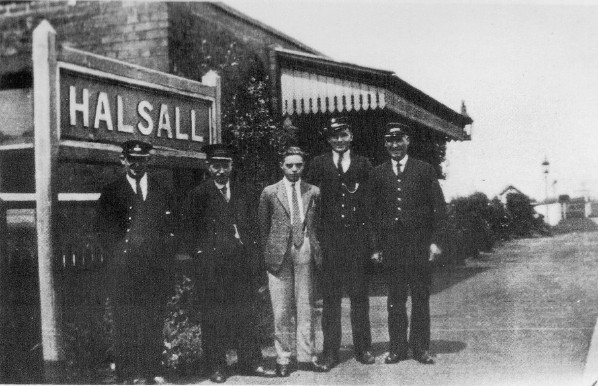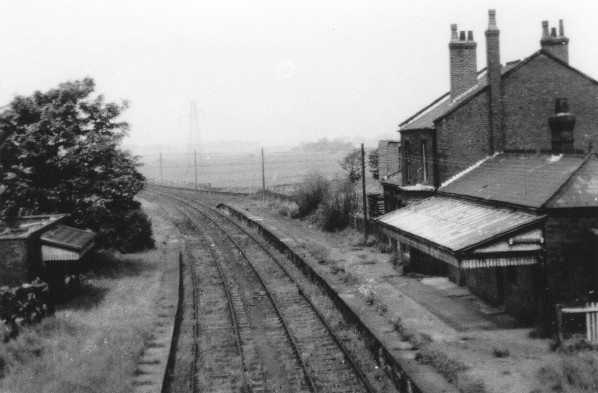|
Notes: Halsall station was situated on the Liverpool, Southport & Preston Junction Railway (LSPJR) Barton Branch that ran between two junctions with the West Lancashire Railway (WLR) on the east side of Southport to Hillhouse Junction on the Southport & Cheshire Lines Extension Railway (S&CLER), just north-west of Altcar & Hillhouse station. Halsall was half-a-mile to west of the village, north of Carr Moss Lane which crossed the line on an overbridge.
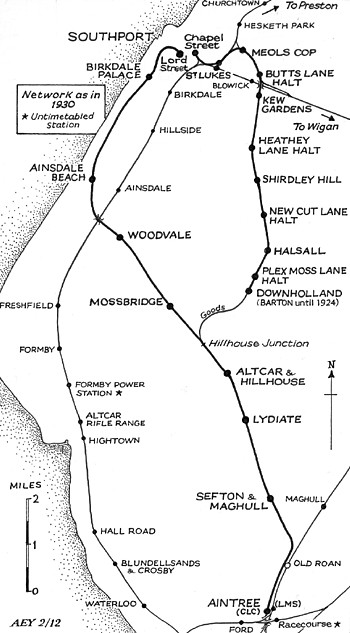 |
The LSPJR was authorised on 7 August 1884 to build a 7½-mile route to link the WLR line to the S&CLER. It was really a creature of the WLR who were its main backers. The WLR wanted to develop an alternative route to Liverpool which, in theory, would compete with the Lancashire & Yorkshire Railway (LYR). However the LYR had much more direct routes from both Southport and Preston to Liverpool. The line was built by C Braddock and was inspected on 20 August 1887. It was planned to open on 1 September 1887 but the contractor was in dispute with the LSPJR, and he removed rails at both of the junctions with the WLR. An injunction was sought and the line opened on 2 September 1887.
There appears to be some confusion about just when a full passenger service was operating and it was not until 1 November 1887 that the first trains ran as far as Altcar & Hillhouse.
The line was double-track, and the station was provided with two platforms. The main facilities were in a single-storey brick building on the up (southbound) Altcar & Hillhouse-direction platform. The building had a canopy that extended over the width |
of the platform. On the north side of the station building andadjacent to it was a two storey house for the station master and, on its north side, a further single-storey building that housed toilets.
Goods facilities were east of the line, adjacent to the passenger station and consisted of three sidings. A Railway Signal Company timber signal box with an 11-lever frame was north of the station on the down side of the line; it controlled traffic movements through the station and access to the goods yard. There was a crossover close to the box, with a slip that connected the down main line to the goods yard.
Initially six trains ran in each direction between Southport Central and Altcar & Hillhouse but, owing to insufficient use, the service was reduced to four trains in each direction. From May 1888 the WLR operated through services between their Preston terminus and the Cheshire Lines Committee (CLC) Liverpool Central station. The trains ran via Halsall, but it is not known if they served the station. Through goods services also ran between the CLC and the WLR via the Barton branch. In December 1895 there were weekday departures from Halsall for Southport Central at 8:29am, 2:24pm, 5:24pm and at 9:19pm. To Altcar & Hillhouse there were trains at 7:24am, 12:54pm, 4:44pm and 8:04pm. There were also three trains in each direction on Sundays.
The LSPJR and its sponsor, the WLR, struggled financially from the start and were insolvent by the 1890s. Despite grand plans both had become nothing more than local lines which, unfortunately, ran through sparsely populated areas for much of their length. As a result both companies were absorbed into the Lancashire & Yorkshire Railway (LYR) on 15 July 1897. On 1 May 1901 the LYR closed Southport Central and diverted the Barton line trains into their Southport Chapel Street station. They also ceased to operate through trains between Preston and Liverpool Central. They did gain running powers over the SCLER up to Aintree, but it appears that very little traffic actually ran that way from the Barton branch.
| In July 1906 the LYR introduced a ‘railmotor’ service which became known as ‘Altcar Bob’. Consisting of an engine and single coach combination with a driving cab at one end of the coach there are a number of suggestions how the service acquired its name. Some local people say that the original driver was called Bob, while others think that the name could be related |
 |
to the ticket fare, ‘bob’ being the general term for a shilling. A more likely explanation is that it was named by railwaymen who, it is said, referred affectionately to small engines as ‘Bob’.
From the 1st of January 1917 until May 1919 the railmotor ceased to run as far as Altcar & Hillhouse as the SCLER was closed as part of a wartime economy measure. All services would have terminated at Barton.
On 1 January 1922 Halsall station became part of the London & North Western Railway (LNWR) after they absorbed the LYR. The July 1922 timetable showed ten weekday departures from Halsall for Southport Chapel Street, four for Altcar & Hillhouse and six for Barton. The following year the LNWR merged with other companies to form the London Midland & Scottish Railway (LMS).
With effect from 13 November 1926 passenger services were withdrawn to Altcar & Hillhouse and all southbound services terminated at Barton, which had been renamed Downholland on 2 June 1924. In summer 1932 the LMS operated ten weekday services to Southport Chapel Street and ten in the return direction. The first departure from Halsall was for Downholland at 7:03am and the first departure for Southport Chapel Street was at 7:13am. The last Downholland service was at 9:43pm and the last Southport departed at 9:53pm.
Since the railway opened there had been no significant growth of housing along its route beyond Southport, and the mosslands remained thinly populated. During the 1930s competition from local buses had a detrimental impact on the number of passengers and, as a result, the passenger service was withdrawn completely on 26 September 1938. The last train ran on Saturday 24 September 1938 and was operated by a conventional locomotive and coaches.
Halsall remained open for goods services, but some time between March 1939 and December 1940 the down line from Downholland to Kew Gardens was closed and converted into a storage siding, with the up line becoming a single line worked by pilot guard. A pilot guard travelled with a daily goods train and worked the signal boxes as shunt frames. In 1945 Halsall box was closed and replaced with a ground frame. The line from Butts Lane Junction through Halsall to Downholland was converted to ‘one engine in steam’ regulations using a round, black single-line staff.
On 1 January 1948 Halsall became part of the nationalised British Railways (London Midland Region). British Railways withdrew the goods service on 21 January 1952 and closed the line from a point just north of Shirdley Hill to Downholland. The track was left in situ until the early 1960s.
Halsall station was later developed into a private residential property although it was substantially altered.
Tickets by Michael Stewart,Bradshaw by Nick Catford and route map drawn by Alan Young.
Sources:
- The Lancashire & Yorkshire Railway Vol 1, John Marshall, David & Charles 1969
- Merseyside & District Railway Stations, by P Bolger, 1994, The Bluecoat Press.
- The Cheshire Lines Committee, by P Bolger, 1984, Heyday Publishing Company.
- Lost Railways of Lancashire, by G Suggitt, 2003, Countryside Books.
- Bradshaw Timetable December 1895.
- Bradshaw Timetable July 1922.
- LMS Timetable Summer 1932.
- The research notes of Tony Graham taken from the National Archives.
For more about Altcar Bob see the Southport.gb.com
web site.
To see the other
stations on the Southport - Altcar & Hillhouse line click
on the station name: Southport
Central, Southport
Ash Street, St. Lukes,
Meols Cop, Butts
Lane Halt, Kew
Gardens, Heathey
Lane Halt, Shirdley
Hill, New
Cut Lane Halt, Plex
Moss Lane Halt, Downholland
& Altcar
& Hillhouse
|

old2.jpg)
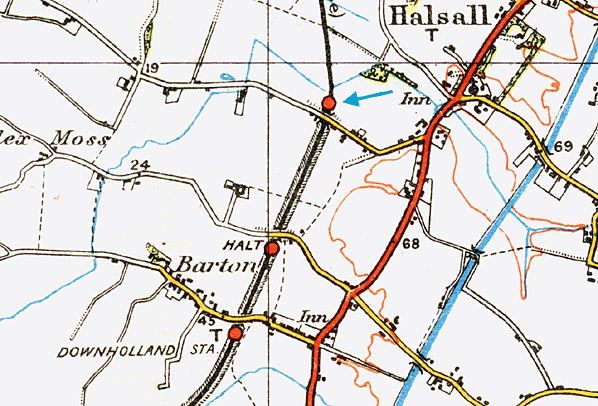
old1.jpg)
.jpg)
.jpg)
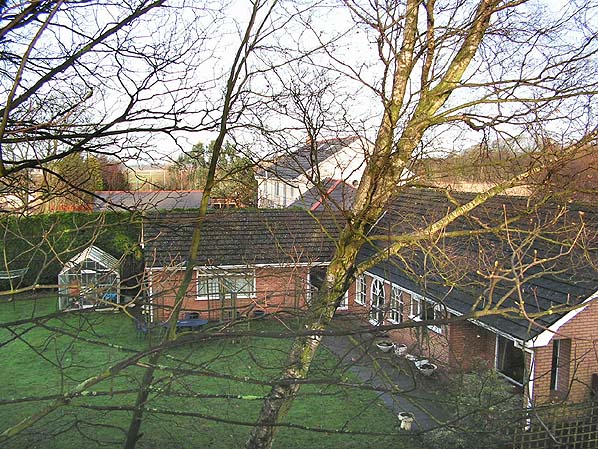
 Home
Page
Home
Page



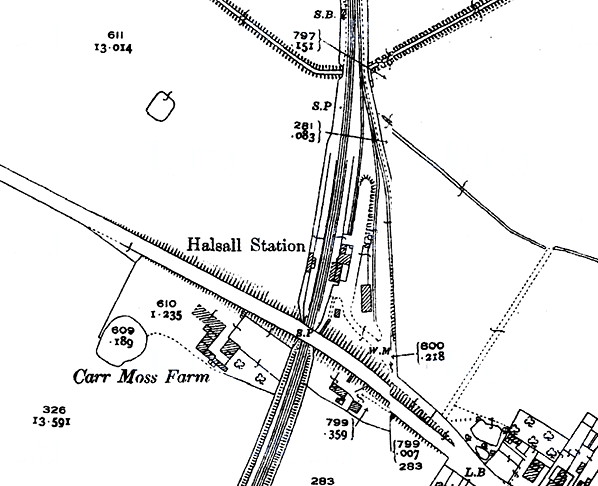 Halsall station as seen on a 1928 map.
Halsall station as seen on a 1928 map. 